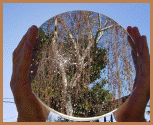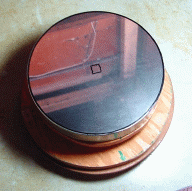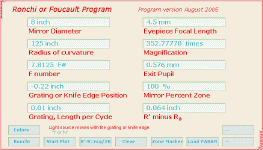 This mirror has lots of pinholes. We never see pinholes after re coating a
mirror. I suspect that they may be caused by salt air. If the mirror is kept in
the damp in this condition for a few years the mirror at the edge at the pin
holes may be marked by a reaction with the aluminum. If you want to preserve a
mirror like this without recoating I would wash and dry it then seal it with
something. Possibly cover it with acid free paper or cloth then seal it in aluminum foil.
This mirror has lots of pinholes. We never see pinholes after re coating a
mirror. I suspect that they may be caused by salt air. If the mirror is kept in
the damp in this condition for a few years the mirror at the edge at the pin
holes may be marked by a reaction with the aluminum. If you want to preserve a
mirror like this without recoating I would wash and dry it then seal it with
something. Possibly cover it with acid free paper or cloth then seal it in aluminum foil.
Other mirrors we get for re coating appear to have been spray painted
with aluminum paint. We think this is caused by trying to clean the mirror
with vinegar. Sometimes the mirrors have spider web or snail tracks. These
need to be cleaned with paint thinner or maybe even ethyl acetate before
removing the old coating.
 This
mirror is more typical of mirrors we see that are ready for re-coating.
The hazy film scatters light reducing contrast of fine detail in the
image. If the haze is caused by plant resins or nicotine and dust then cleaning
will often help. If caused by pool chemicals then cleaning won't help.
This
mirror is more typical of mirrors we see that are ready for re-coating.
The hazy film scatters light reducing contrast of fine detail in the
image. If the haze is caused by plant resins or nicotine and dust then cleaning
will often help. If caused by pool chemicals then cleaning won't help.
This coating is almost three years old but deteriorating faster than
expected. The cardboard tube for this scope had been painted with the
green wood preservative which supposedly never dries. The scope was stored
in the vertical position and apparently over time some of the preservative
settled on the mirror and polymerized with inclusion of dust. Holding the
mirror up to a bright light as a sun filter shows the aluminum was corroded as
in this page background. Cleaning did not help. When the marker pen marks were
removed with methanol the coating where the marker pen marks had been was not
deteriorated. Also no deterioration was noted on the diagonal mirror.
 A week after recoating and installing we
tested the telescope at Fremont Peak on a
night with excellent seeing. The mirror focal length is 62.5 inches and we
used a 2 x 'Shorty Barlow' with an old Edcorp 9 mm
eyepiece giving about about 350 magnification. The diagonal is a good Edmund
diagonal. Testing on e Lyre, the double double, the resolution appeared to be
less than 1 arc second. A mottled first diffraction ring was visible around
the Ary disk at best focus. Resolving the double double was not a real challenge for
the scope, more challenging was keeping the image in the field of view with the
Dobsonian mount pointed almost straight up.
A week after recoating and installing we
tested the telescope at Fremont Peak on a
night with excellent seeing. The mirror focal length is 62.5 inches and we
used a 2 x 'Shorty Barlow' with an old Edcorp 9 mm
eyepiece giving about about 350 magnification. The diagonal is a good Edmund
diagonal. Testing on e Lyre, the double double, the resolution appeared to be
less than 1 arc second. A mottled first diffraction ring was visible around
the Ary disk at best focus. Resolving the double double was not a real challenge for
the scope, more challenging was keeping the image in the field of view with the
Dobsonian mount pointed almost straight up.